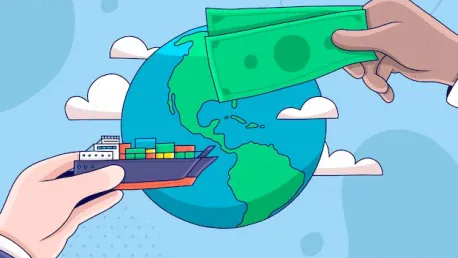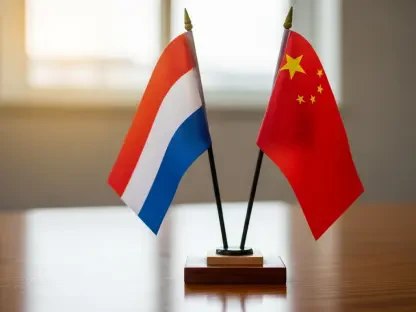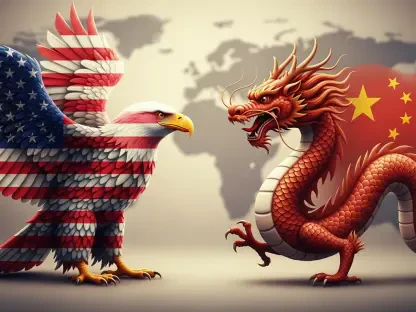Have you ever wondered how a single policy change can ripple across the globe, altering markets and economies far and wide? This was the reality when the Trump administration imposed tariffs that sent shockwaves through international trade. One might be surprised to learn that, according to the US Chamber of Commerce, some tariffs introduced resulted in an estimated $6 billion annual tax increase on American businesses. But what does this mean for the global economy, and why should it matter to us?
The Economic Shock of Trump’s Tariffs
When the Trump administration unexpectedly imposed tariffs, it raised more than just eyebrows. The immediate impact saw global trade turn turbulent almost overnight, exemplifying the interconnected nature of modern economies. For instance, global steel prices surged by 9% within months, dramatically affecting industries dependent on this crucial material.
These tariffs highlighted the volatility of international trade and underscored the immense influence of US trade policies on global markets. Businesses and governments alike were forced into a reactive stance, indicating just how critical and far-reaching these changes were.
Why This Matters: The Stakes of US Trade Policy
Why is it important to discern the significance of these tariffs beyond their headlines? It’s because tariffs serve a dual purpose: they protect local businesses while potentially triggering broader economic consequences. On one hand, tariffs can shield domestic industries from foreign competitors, thus preserving jobs. On the other, they can incite job losses in sectors reliant on international trade, escalating trade tensions and fostering economic uncertainty.
The real-world ramifications are evident in the US-China trade relations, where tariffs led to $11 billion in losses for American technology firms alone. Trade policies once thought to secure the economy can often instigate a cycle where one nation’s gain is another’s loss, making clear the high stakes involved in such decisions.
Deconstructing Tariffs: Basics and Beyond
Tariffs, essentially taxes on imported goods, aim to balance the economic scales. While reciprocal tariffs imply mirrored taxation, retaliatory tariffs act as economic sanctions. To understand how these mechanisms work, consider the US-China dynamic: reciprocal tariffs saw similar levies on products from each country, whereas retaliatory tariffs were punitive responses to perceived economic aggression.
Examples in the real world underscore these actions. Both China and South Korea implemented tariffs in response to Trump’s policies, showcasing the reactive nature of global trade dynamics. These situations illustrate the complexity and strategic deployment of tariffs in international trading.
Unpacking Trade Wars: Consequences and Dynamics
Trade wars signify a series of escalating, retaliatory tariffs between countries, potentially destabilizing the global economy. The infamous US-China trade war commenced in earnest in 2018, with tariffs on over $300 billion in goods. This tit-for-tat battle, characterized by up to 25% tariffs on various products, caused significant economic ramifications globally.
The economic fallout is hard to ignore. The World Bank noted a 1.4% reduction in global trade growth within a year following the trade war’s escalation. Businesses worldwide struggled to navigate the resulting uncertainty, underscoring the sweeping impacts trade wars can command.
Trade Deficit and Surplus: A Balancing Act
Trade deficits and surpluses are critical gauges of an economy’s health. A trade deficit, where imports exceed exports, can strain national economies, whereas a surplus indicates a robust trade position. The US’s persistent trade deficit with China, driven by massive imports of electronics and textiles, exemplifies these dynamics.
Conversely, the US’s trade surplus with The Netherlands highlights successful exports of agricultural products and machinery. These trade balances not only affect economic policy but also shape geopolitical relations.
Subsidies: Government Support and Market Distortion
Subsidies, financial aids from the government to local businesses, serve as strategic tools to mitigate the impact of tariffs. South Korea, for instance, ramped up subsidies for its automobile and technology sectors in response to US tariffs. This financial support was aimed at bolstering local market competitiveness, thereby distorting typical market dynamics.
However, subsidies are not without controversy. They can skew competition, often leading to long-term economic imbalances. These actions reflect how governments maneuver within the intricate confines of international trade laws to protect their domestic markets.
Stock Market Reactions: Indicators of Economic Health
The stock market is a vital indicator of economic health, sensitive to major policy shifts like tariffs. Indices such as the S&P 500 and Dow Jones Industrial Average often react sharply to trade developments. For instance, the announcement of new tariffs in 2019 saw the Dow plunge by almost 800 points in one day, reflecting market fears.
Such volatility emphasizes the interconnectedness of global trade and securities markets. Investors keenly watch these indices for signs of economic trajectory, affected by decisions made far beyond local borders.
The Federal Reserve’s Role: Managing the Economic Fallout
The Federal Reserve, the United States’ central bank, plays a crucial role in stabilizing the economy amid trade wars. By adjusting interest rates, the Fed aims to manage inflation and stimulate growth. For example, in response to the uncertainties of the trade war, the Fed cut interest rates to bolster economic confidence.
These monetary policies act as cushions, aiming to mitigate adverse effects from fluctuating trade policies. The Fed’s actions underscore the delicate balance central banks maintain in steering economic stability amidst external shocks.
Inflation and Exchange Rates: The Ripple Effect
Inflation, the rate at which prices for goods and services rise, is intricately linked to tariff policies and resultant economic shifts. Higher tariffs often mean increased costs for imported goods, contributing to inflation.
Exchange rates, determining the value between currencies, further compound these effects. For example, a stronger US dollar can make imports cheaper but exports more expensive, influencing international trade balances. These elements create a ripple effect, deeply woven into the fabric of economic health and policy.
Market Trends: Navigating Bull and Bear Markets
Market trends, particularly bull (rising) and bear (falling) markets, are pivotal for understanding economic directions. Tariffs can significantly influence these trends, as seen in the fluctuating market conditions during trade wars. The initial rounds of tariffs often sparked fears of economic slowdown, setting off bear market trends.
However, markets sometimes exhibit resilience, transitioning into bull markets when policy stability returns. This oscillation underlines the importance of tariff policies in shaping economic behavior and investor confidence.
National Debt: The Fiscal Implications
National debt, the sum of government borrowings, has climbed significantly in the wake of trade policies and economic strategies. For instance, recent policies have seen US national debt rise to approximately $36.56 trillion. This growing debt heightens fiscal health concerns, echoing the broader implications of aggressive economic policies.
Increased national debt can have long-term repercussions, affecting interest rates and financial stability. It showcases how trade policies can have cascading effects on national fiscal health, presenting critical challenges for economic management.
Trade Agreements: Cooperation vs. Competition
Trade agreements aim to facilitate smooth exchanges between countries. Free Trade Agreements (FTAs) eliminate barriers, promoting freer trade, while Bilateral Trade Agreements set specific terms between two nations. These agreements are strategic tools in enhancing economic cooperation and fostering competitive trade environments.
For instance, the US-Mexico-Canada Agreement (USMCA) exemplifies the role of trade agreements in shaping economic landscapes, demonstrating the balance between cooperation and competition in international trade policies.
Gross Domestic Product: Measuring Economic Impact
Gross Domestic Product (GDP) measures the total value of goods and services produced, offering a snapshot of economic health. Tariffs can directly influence GDP by affecting trade balances and industrial output. The US experienced notable GDP changes amid shifting trade policies, emphasizing the deep ties between tariffs and economic performance.
These variations highlight the importance of stable trade policies in fostering economic growth. Policymakers closely monitor GDP as an economic health indicator, adjusting strategies to optimize performance and stability.
Recession: Anticipating Downturns
Recessions, characterized by two consecutive quarters of GDP decline, often bring job losses and reduced spending. History reveals that trade wars and aggressive tariffs can act as catalysts for such downturns, as seen in the economic slowdowns during past trade disputes.
Recognizing the indicators of impending recessions allows policymakers and businesses to prepare and respond proactively, aiming to cushion the economy from severe impacts.
Practical Strategies for Navigating Tariff Impacts
Navigating the complexities of tariffs requires strategic planning for businesses and investors. Diversifying supply chains, exploring new markets, and implementing cost-management strategies are essential steps. Businesses can also leverage trade agreements to mitigate tariff impacts and exploit emerging opportunities.
These proactive measures ensure adaptability in ever-changing economic landscapes, offering resilience against the uncertainties of international trade policies.
In conclusion, the global economic impact of Trump’s tariffs underlined the far-reaching and multifaceted consequences of trade policies. Examining the ripple effects on trade balances, market trends, and national debt emphasized the intricate dynamics at play. Recognizing the past’s lessons provides valuable insights for shaping future trade strategies, ensuring economic resilience and stability amid an interconnected global economy.









